OIL PLATFORMS
An oil platform is a large structure used to house workers and machinery needed to drill and then produce oil and natural gas in the ocean. Depending on the circumstances, the platform may be attached to the ocean floor, consist of an artificial island, or be floating.
Generally, oil platforms are located on the continental shelf though as technology improves, drilling and production in ever deeper waters becomes both feasible and profitable. A typical platform may have around thirty wellheads located on the platform and directional drilling allows reservoirs to be accessed at both different depths and at remote positions up to 5 miles (8 kilometres) from the platform.
Many platforms also have remote wellheads attached by umbilical connections, these may be single wells or a manifold centre for multiple wells.
Oil Platform Hibernia
Platform types
Larger lake and sea-based oil platforms and oil rigs are some of the largest moveable man-made structures in the world. There are several distinct types of platforms and rigs:
Fixed Platforms, built on concrete and/or steel legs anchored directly onto the seabed, supporting a deck with space for drilling rigs, production facilities and crew quarters. Such platforms are, by virtue of their immobility, designed for very long term use (for instance the Hibernia platform). Various types of structure are used, steel jacket, concrete caisson, floating steel and even floating concrete. Steel jackets are vertical sections made of tubular steel members, and are usually piled into the seabed. Concrete caisson structures, pioneered by the Condeep concept, often have in-built oil storage in tanks below the sea surface and these tanks were often used as a flotation capability, allowing them to be built close to shore (Norwegian fjords and Scottish firths are popular because they are sheltered and deep enough) and then floated to their final position where they are sunk to the seabed. Fixed platforms are economically feasible for installation in water depths up to about 1,700 feet (520 m).
Compliant Towers, consist of narrow, flexible towers and a piled foundation supporting a conventional deck for drilling and production operations. Compliant towers are designed to sustain significant lateral deflections and forces, and are typically used in water depths ranging from 1,500 and 3,000 feet (450 and 900 m).
Semi-submersible Platforms having legs of sufficient buoyancy to cause the structure to float, but of weight sufficient to keep the structure upright. Semi-submersible rigs can be moved from place to place; and can be lowered into or raised by altering the amount of flooding in buoyancy tanks; they are generally anchored by cable anchors during drilling operations, though they can also be kept in place by the use of steerable thrusters. Semi-submersible can be used in depths from 600 to 6,000 feet (180 to 1,800 m).
Jack-up Platforms, as the name suggests, are platforms that can be jacked up above the sea, by dint of legs than can be lowered like jacks. These platforms, used in relatively low depths, are designed to move from place to place, and then anchor themselves by deploying the jack-like legs.
Drillships, a maritime vessel that has been fitted with drilling apparatus. It is most often used for exploratory drilling of new oil or gas wells in deep water but can also be used for scientific drilling. It is often built on a modified tanker hull and outfitted with a dynamic positioning system to maintain its position over the well.
Floating production systems are large ships equipped with processing facilities and moored to a location for a long period. The main types of floating production systems are FPSO (floating production, storage, and offloading system), FSO (floating storage and offloading system), and FSU (floating storage unit).
Tension-leg Platforms, consist of floating rigs tethered to the seabed in a manner that eliminates most vertical movement of the structure. TLPS are used in water depths up to about 6,000 feet (2,000 m).
Seastars are mini TLPs of relatively low cost, used in water depths between 600 and 3,500 feet (200 and 1,100 m). They can also be used as utility, satellite or early production platforms for larger deepwater discoveries.
Spar Platforms, moored to the seabed like the TLP, but whereas the TLP has vertical tension tethers the Spar has more conventional mooring lines. Spars have been designed in three configurations: the "conventional" one-piece cylindrical hull, the "truss spar" where the midsection is composed of truss elements connecting the upper buoyant hull (called a hard tank) with the bottom soft tank containing permanent ballast, and the "cell spar" which is built from multiple vertical cylinders. The Spar may be more economical to build for small and medium sized rigs than the TLP, and has more inherent stability than a TLP since it has a large counterweight at the bottom and does not depend on the mooring to hold it upright. It also has the ability, by use of chain-jacks attached to the risers, to move horizontally over the oil field. The first Spar was Kerr-McGee's Neptune, which is a floating production facility anchored in 1,930 feet (588 m) in the Gulf of Mexico. Dominion Oil's Devil's Tower is located in 5,610 feet (1,710 m) of water, in the Gulf of Mexico, and is the world's deepest spar. The first (and only) cell spar is Kerr-McGee's Red Hawk.

Oil Platform California USA
Maintenance and supply
A typical oil production platform is self-sufficient in energy and water needs, housing electrical generation, water desalinators and all of the equipment necessary to process oil and gas such that it can be either delivered directly onshore by pipeline or to a Floating Storage Unit and/or tanker loading facility. Elements in the oil/gas production process include wellhead, production manifold, production separator, glycol process to dry gas, gas compressors, water injection pumps, oil/gas export metering and main oil line pumps. All production facilities are designed to have minimal environmental impact.
Larger platforms are assisted by smaller ESVs (emergency support vessels) like the British Iolair that are summoned when something has gone wrong, e.g. when a search and rescue operation is required. During normal operations, PSVs (platform supply vessels) keep the platforms provisioned and supplied, and AHTS vessels can also supply them, as well as tow them to location and serve as standby rescue and firefighting vessels.
Risks
The nature of their operation — extraction of volatile substances sometimes under extreme pressure in a hostile environment — has risk and not infrequent accidents and tragedies occur. In July 1988, 167 people died when Occidental Petroleum's Alpha offshore production platform, on the Piper field in the North Sea, exploded after a gas leak. The accident greatly accelerated the practice of housing living accommodation on self-contained separate rigs, away from those used for extraction.
However, this was, in itself, a hazardous environment. In March 1980, the 'flotel' (floating hotel) platform Alexander L Keilland capsized in a storm in the North Sea with the loss of 123 lives.
Further risks are the leaching of heavy metals that accumulate in buoyancy tanks into water; and risks associated with their disposal. There has been concern expressed at the practice of partially demolishing offshore rigs to the point that ships can traverse across their site; there have been instances of fishery vessels snagging nets on the remaining structures. Proposals for the disposal at sea of the Brent Spar, a 137-metre (449 ft) tall storage buoy (another true function of that which is termed an oil rig), was for a time in 1996 an environmental cause célèbre in the UK after Greenpeace occupied the floating structure. The event led to a reconsideration of disposal policy in the UK and Europe, though Greenpeace, in hindsight, admitted some inaccuracies leading to hyperbole in their statements about Brent Spar.
Environmental effects
In British waters, the cost of removing all platform rig structures entirely was estimated in 1995 at £1.5 billion, and the cost of removing all structures including pipelines — a so-called "clean sea" approach — at £3 billion.
In the United States, Marine Biologist Milton Love has proposed that oil platforms off the California coast be retained as artificial reefs, instead of being dismantled (at great cost), because he has found them to be havens for many of the species of fish which are otherwise declining in the region, in the course of 11 years of research. Love is funded by mainly by government agencies, but also in small part by the California Artificial Reef Enhancement Program. NOAA has said it is considering this course of action, but wants money to study the effects of the rigs in detail.
In the Gulf of Mexico, more than 200 platforms have been similarly converted.
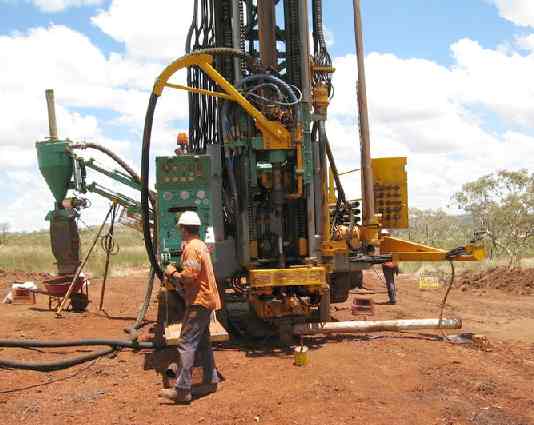
Mobile RC Oil Rig
Large platforms
The Petronius platform is an oil and gas platform in the Gulf of Mexico, which stands 2,000 feet (610 metres) above the ocean floor. This structure is partially supported by buoyancy. Depending on the criteria it may be the world's tallest structure.
The Hibernia platform is an oil and gas platform in the Atlantic Ocean off the coast of Newfoundland. The gravity base structure sits on the ocean floor in 200 m (660 ft) of water with its topsides extending 50 m (160 ft) above the surface. The platform acts as a small concrete island with serrated outer edges designed to withstand the impact of an iceberg. The GBS contains production storage tanks and the remainder of the void space is filled with ballast with the entire structure weighing in at 1.2 million tons.
History
The first oil platform in the world is the Oil Rocks (Neft Daşları), built near Baku in Azerbaijan. This platform was built in 1947 as an exercise of Soviet and Azeri ambition. The Oil Rocks lies 45–50 km (about 25 nautical miles) offshore on the Caspian Sea. The most unique feature of the Oil Rocks is that it is actually a functional city with a population of about 5000. The Oil Rocks is a city on the sea, with over 200 km of streets built on piles of dirt and landfill. Most of the inhabitants work on shifts; a week on Oil Rocks followed by a week on the shore. The small city includes shops, school, library, etc. After almost 60 years the Oil Rocks is still quite unique as the world's first and largest oil platform.
DRILLING RIGS
A drilling rig or oil rig is a structure housing equipment used to drill for water, oil or natural gas from underground reservoirs. Sometimes a drilling rig is also used to complete (prepare for production) the well. However, the rig itself is not involved with the extraction of the oil, its primary function is to make a hole in the ground so that the oil can be produced. Drilling rigs can also be used to drill for water or for exploration purposes, or to obtain mineral core samples.
The term can refer to a land-based rig, or a marine-based structure commonly called an 'offshore rig'. The term correctly refers to the equipment that drills the oil well including the rig derrick (which looks like a metal frame tower). Laypeople also refer to the structure upon which the rig sits and from which the wells produce as a 'rig', but this is not correct. The correct name for the structure in a marine environment is platform. A structure upon which wells produce is a production platform. A floating vessel upon which a drilling rig sits is afloating rig or semi-submersible rig because the whole purpose of the structure is for drilling.
Drilling rigs can be huge, capable of drilling through thousands of metres of the Earth's crust; large "mud pumps" are used to circulate drilling mud (slurry) through the drill bit and the casing, for cooling and removing the "cuttings" whilst a well is drilled; hoists in the rig can lift thousands of tons of pipe; other equipment can force acid or sand into reservoirs to facilitate extraction of the oil; and permanent living accommodation and catering for crews which may be greater than a hundred people in number. Marine rigs may operate many hundreds of miles or kilometres offshore with infrequent crew rotation.
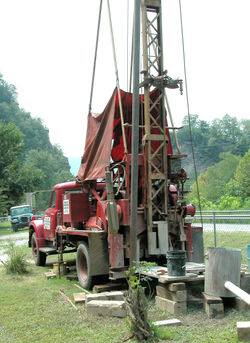
Mobile Oil Well Spudder
The drilling and production of oil and gas pose a safety risk and a hazard to the environmentfrom the ignition of the entrained gas causing dangerous fires and also from the risk of oil leakage polluting water, land and groundwater. For these reasons, redundant safety systems and highly trained personnel are required by law in all countries with significant production.
Mobile drilling rigs
In early oil exploration, drilling rigs were semi-permanent in nature often being built on site and left in place after the completion of the well. In more recent times drilling rigs are expensive custom built machines that are capable of being moved from well to well. Some light duty drilling rigs are similar in nature to a mobile crane though these are more usually used to drill water wells. Larger land rigs must be broken apart into multiple sections and loads in order to move to a new location, a process which can often take weeks.
Small mobile drilling rigs are also used to drill or bore piles. Rig can range from 100 ton continuous flight auger (CFA) rigs to small air powered rigs used to drill holes in quarries, etc. These rigs use the same technology and equipment as the oil drilling rigs, just on a smaller scale.
The drilling mechanisms outlined below differ mechanically in terms of the machinery used, but also in terms of the method by which drill cuttings are removed from the cutting face of the drill and returned to surface.
OIL EXPLORATION
Since our appetite for cheap energy appears insatiable, it is necessary to search and find oil to replace the wells that are running dry. Oil rigs are used to drill exploration wells to look for oil. And oil platforms are used to drill into an oil field to extract the oil. There are several different types of oil rig and platform.
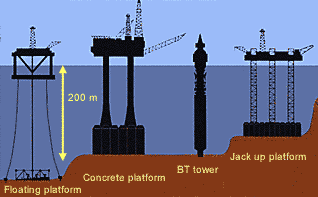
Types of offshore oil platforms
Notice how tall the offshore platforms are compared with the BT tower in London. The water in the North Sea is often over 200 metres deep. Floating rigs, more like ships are used to drill test holes and find oil. These are held (moored) in place by anchor chains or computer-controlled propellers.
Oil platforms are huge structures. Some have concrete legs that sit on the sea bed. They had to be made in a shipyard and towed out to sea. Some oil platforms are also held by giat sea anchors. Other platforms have metal legs - sometimes they are jacked up. People who work on oil platforms have to go to work by helicopter.
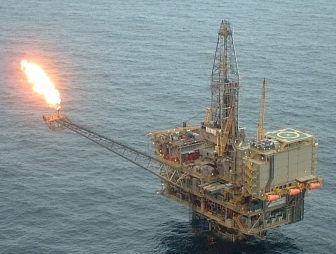
Some oil reservoirs need to be pumped. In this case, there are small pumps inside the well pipes. Also, water is pumped into the well to force the crude oil mixture out. This water is pumped down injector wells while the oil is pumped out of production well. The top end of the well is called the well head. This is where the oil is removed from the well.
An oil well gets its name from traditional water wells. It is a hole that is drilled into the ground to reach a reservoir of liquid - in this case oil. However, an oil well can be a little more complicated than a water well - especially oil wells under the sea bed. First of all, the drill thread has to be lowered to the sea bed before it can start drilling through the cap rock.
Secondly, the well often spans out horizontally once has penetrated the reservoir. This is because the oil is held in porous rock - it is not like an underground stream. Often the oil has to be pumped out of the rock. It is only oil close to the end of well that is retrieved.
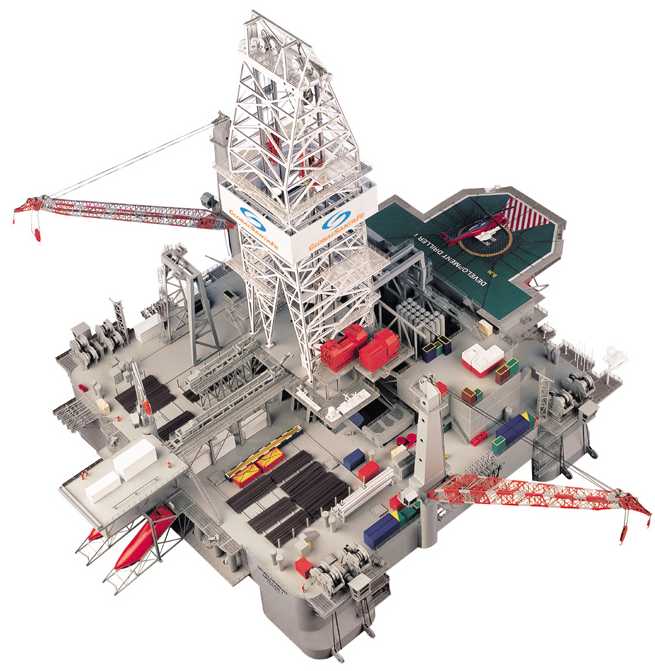
CRUDE OIL
Crude oil is sold between countries in quantities called barrels. (The same measurement is used to sell whisky.)
One barrel of oil is the same as:
159 litres (about 80 large fizzy drink bottle)
35 gallons (enough to fit in the petrol tanks of about 4 cars)
280 pints (a lot of bottles of milk)
The weight of a barrel depends on where the oil comes from. However, there are about 8 barrels in a tonne. You could fit nearly 2 million barrels of oil into a football stadium - or one and a half tankers. This is how much oil we use in the UK every day.
In 2004 the cost of a barrel of crude oil rose to a record of $50 - about £30.
|
Gallons of fuel barrel of oil going as products are shown above and below
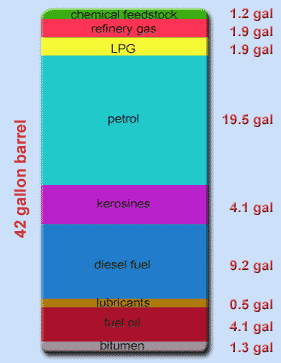
The oil we find underground is called crude oil. Crude oil is a mixture of hydrocarbons - from almost solid to gaseous. These were produced when tiny plants and animals decayed under layers of sand and mud millions of years ago. Crude oil has to be changed before it can be used for anything. This happens in an oil refinery.
Crude oil doesn't always look the same – it depends where it comes from. Sometimes it is almost colourless, or it can be thick and black. But crude oil usually looks like thin, brown treacle.
It's not just the appearance of crude oil that changes. Crudes from different sources have different make-ups. Some may have more of the valuable lighter hydrocarbons and some may have more of the heavier hydrocarbons. The compositions of different crudes are measured and published in assays. The refinery uses the information in these assyas to decide which crudes it will buy to make the products that its customers need at any given time.
When crude oil comes out of a well (especially an undersea well), the crude oil is often mixed with gases, water and sand. It forms an emulsion with the water that looks a bit like caramel. The sand is suspended in the emulsion, adding to the caramel effect. The sand will settle out and the water is removed using de-emulsifying agents. They have to be separated from the crude oil before it can be processed ready for transportation by tanker or pipeline.
The dissolved gases have to be removed at the well. Otherwise, they might come out of solution and cause a build up of pressure in a pipe or a tanker. The crude oil also contains sulphur. This has to be removed from any fractions that are going to be burnt because it forms sulphur dioxide which contributes to acid rain. So any fractions that go into fuels pass through hydrofiners to remove the sulphur.
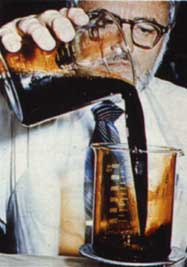
Crude Oil





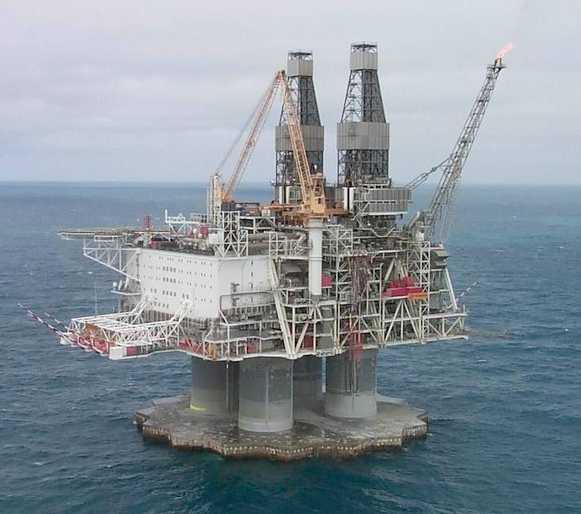
.jpg)


















.bmp)
























































.jpg)

